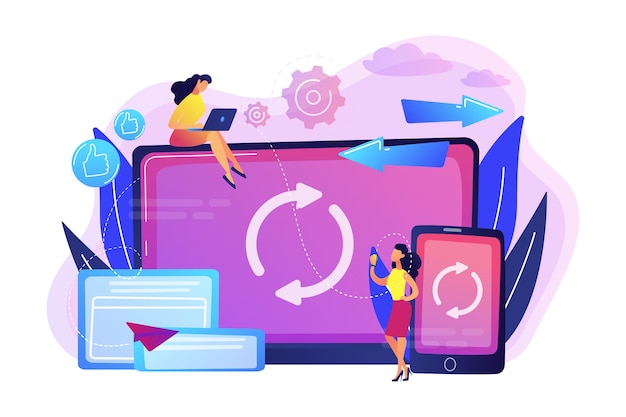- Introduction
- What is SAAS Development?
- Why is SAAS Development Important?
- The SAAS Development Process
- Industries and Use Cases for SAAS Development
- Challenges of SAAS Development
- Risks and Considerations in SAAS Development
- Conclusion
- Frequently Asked Questions (FAQs)
Table of Contents
What is SAAS Development and Why it's Important?

Introduction
SAAS software development is revolutionizing how businesses and individuals interact with technology in today's fast-paced digital landscape. By delivering software over the internet on a subscription basis, SAAS eliminates the need for installation and maintenance.
This blog explores SAAS development's benefits, processes, and its impact across various industries. We'll highlight key differences between SAAS and traditional software development, addressing challenges and risks.
Partnering with a reliable SAAS application development company for businesses considering this model can ensure seamless integration, scalability, and ongoing support, driving efficiency and success in the modern tech environment.
What is SAAS Development?
SAAS development, short for Software as a Service development, is the process of creating software applications that are delivered over the internet to users on a subscription basis. In simple terms, SAAS development enables users to access and use software without the need to install or maintain it on their own devices.
SAAS development is an important aspect of modern technology as it offers numerous advantages for both businesses and individuals. From cost savings to scalability, SAAS development provides a flexible and accessible solution for software needs.
This blog explores the intricacies of SAAS development, its benefits, the process involved, and the industries that can benefit from it.
By understanding what SAAS development is and why it's important, individuals and businesses can make informed decisions about adopting this innovative software delivery model.
The SAAS Model and its Key Components
SAAS (Software-as-a-Service) is a software distribution model where software is provided as a service over the internet, eliminating the need for customers to install and maintain the software on their own machines.
The key components of the SAAS model include:
- Multi-tenancy: SAAS applications are built to serve multiple customers, known as tenants, from a single instance of the application. This allows for efficient scaling and cost savings.
- Cloud infrastructure: SAAS applications are typically deployed on cloud infrastructure, such as Amazon Web Services (AWS) or Microsoft Azure, to provide scalability, reliability, and high availability.
- Subscription pricing: SAAS applications are usually offered on a subscription basis, where customers pay a recurring fee to access and use the software. This model provides flexibility and affordability for customers.
- Automatic updates: SAAS providers are responsible for maintaining and updating the software, ensuring that customers always have access to the latest features and security patches without any effort on their part.
- Integration capabilities: SAAS applications often offer integration capabilities to connect with other systems and services, allowing customers to streamline their workflows and share data between different applications.
- Access via web browser: SAAS applications are accessed through a web browser, eliminating the need to install and configure software on individual user devices. This allows for easy accessibility from anywhere with an internet connection.
SAAS Development vs Traditional Software Development
SAAS development differs from traditional software development in several ways:
- SAAS applications differ from traditional software in several ways. Unlike traditional software, SAAS applications are accessed through a web browser, removing the need for installation.
- The SAAS model allows for greater scalability, as resources can be allocated dynamically based on user demand.
- Additionally, SAAS applications often involve shorter release cycles, enabling more frequent updates and enhancements to the software.
For businesses seeking to leverage these advantages, SAAS application development services offer the expertise needed to create scalable, efficient, and easily accessible software solutions tailored to their unique needs.
Why is SAAS Development Important?
SAAS development offers a range of benefits for both businesses and individuals. Understanding these benefits can help make a compelling case for adopting SAAS solutions.
Cost Savings and Scalability

One of the most significant advantages of SAAS development is cost savings. Unlike traditional software, SAAS typically operates on a subscription basis, eliminating the need for a large upfront investment. This pay-as-you-go model allows businesses to scale their software usage based on their needs, reducing unnecessary expenses.
Accessibility and Flexibility
SAAS applications are highly flexible because they can be accessed from anywhere with an internet connection. This ease of access enables remote work, collaboration, and seamless integration with other cloud-based tools. Users can access their SAAS applications on various devices, including laptops, tablets, and smartphones, ensuring productivity on the go.
Continuous Updates and Improvements

With SAAS development, software updates are seamlessly delivered to users. This means users do not have to worry about installing updates manually, as they are automatically rolled out by the service provider. This ensures that users are always using the latest version of the software, benefitting from bug fixes, security patches, and new features.
Reduced IT Infrastructure and Maintenance
Since SAAS applications are hosted on the cloud, businesses and individuals do not need to invest in their own dedicated servers or IT infrastructure. This eliminates the need for hardware maintenance and reduces IT support costs. SAAS providers handle server management, security, and upgrades, allowing users to focus on their core business activities instead.
Cost-effectiveness

SAAS development offers cost-effectiveness in multiple ways. Firstly, it eliminates the need for upfront infrastructure investments as the software is hosted in the cloud. This reduces hardware and maintenance costs. Additionally, SAAS applications are typically licensed on a subscription basis, allowing users to pay only for the services they need, resulting in lower overall costs.
Scalability
SAAS applications are designed to be highly scalable, allowing businesses to easily accommodate growing user bases or increasing demands. The infrastructure and resources are managed by the SAAS provider, enabling seamless scaling without disruptions in service for the end-users.
Accessibility and Anywhere, Anytime Usage

One of the key benefits of SAAS development is the ability to access the software from anywhere, at any time, as long as there is an internet connection. This provides users with flexibility and allows for remote collaboration. SAAS applications can be accessed through various devices, enabling users to work from different locations or use different operating systems.
Automatic Updates and Maintenance
With SAAS development, software updates and maintenance tasks are handled by the SAAS provider. This relieves the burden on users to install updates or perform maintenance tasks manually. Users can enjoy the latest features, bug fixes, and security enhancements seamlessly, without the need for their own dedicated IT resources.
Data Security and Backups
SAAS providers typically prioritize data security and implement robust security measures to protect user data. Regular backups and disaster recovery plans are often included, ensuring that data remains safe and can be restored in case of any unforeseen events.
Integration and Customization

SAAS applications often come with integration capabilities, allowing users to connect with other business systems and tools, such as CRM or accounting software. Additionally, SAAS solutions can be customized to align with specific business requirements, providing a tailored experience to users.
User Support and Customer Service
SAAS providers typically offer customer support and dedicated customer service teams to address user queries and issues. This ensures timely assistance and enhances the overall user experience.
These benefits make SAAS development an attractive option for businesses, providing cost savings, scalability, accessibility, automated maintenance, data security, integration, customization, and user support.
The SAAS Development Process
The SAAS development process is crucial for creating successful applications. As a leading SAAS application development company, we guide you through each stage, from conceptualization to maintenance, ensuring exceptional results.
SAAS Development Process
The SAAS development process involves a series of stages essential for creating a successful SAAS application. Each stage is crucial in the overall development journey, from idea conceptualization to ongoing maintenance and updates.
Idea and Conceptualization

Identifying a Problem or Need: The first step in the SAAS development process is identifying a specific problem or need that can be addressed through software.
This involves understanding potential users' pain points and determining how an SAAS solution can provide value.
Brainstorming Potential SAAS Solutions: Once the problem or need is identified, brainstorming sessions are conducted to generate ideas for potential SAAS solutions.
This stage lays the foundation for the development of the software concept.
Market Research and Analysis
Evaluating Target Audience and Potential Competitors: Market research is crucial for understanding the target audience, identifying competitors, and assessing market trends.
This stage helps refine the SAAS idea and validate its market demand.
Assessing Market Demand and Viability: The feasibility and viability of the SAAS solution are evaluated through market analysis.
This involves determining if there is a market need for the product and if it has the potential for success.
Design and Prototyping

Creating Wireframes and Mockups: Design and prototyping involve visualizing the SAAS application's user interface and user experience. Wireframes and mockups outline the software's layout, design elements, and functionality.
Developing a User-Friendly and Intuitive Interface: The focus during this stage is on developing a user-friendly interface that enhances usability and ensures a positive user experience.
The design and prototyping phase sets the foundation for the development of the SAAS product.
Development and Testing
Building the SAAS product using Agile Methodologies: Development involves writing the code and building the SAAS application based on the design and requirements. Agile methodologies are commonly used to promote flexibility, collaboration, and iterative development.
Conducting Thorough Testing and Bug Fixes: Testing is a critical phase that involves identifying bugs, errors, and issues in the SAAS product. Thorough testing ensures that the software functions correctly and meets the specified requirements.
Deployment and Launch
Preparing for Deployment on Cloud Servers: Before deployment, infrastructure configurations and preparations are made to ensure that the SAAS application can be hosted on cloud servers securely and efficiently.
Launching the SAAS Product and Monitoring Initial User Feedback: The deployment stage involves launching the SAAS product to users. Initial user feedback is monitored to gather insights, address any immediate issues, and make necessary adjustments.
Maintenance and Updates

Monitoring Performance and Addressing User Issues: After the SAAS product is live, ongoing monitoring of performance metrics and user feedback is essential.
This stage involves addressing any user issues, ensuring optimal performance, and providing support.
Regularly Updating and Enhancing the SAAS Product: To stay competitive and meet evolving user needs, the SAAS product is regularly updated and enhanced.
This can include bug fixes, feature improvements, and new functionalities based on user feedback and market trends.
The SAAS development process is iterative and dynamic, with each stage contributing to the overall success of the SAAS application. By following these steps systematically and continuously improving the product, developers can create innovative, user-centric SAAS solutions that cater to the needs of their target audience.
Industries and Use Cases for SAAS Development
The versatility of SAAS development allows it to cater to a wide range of industries and use cases. Here are some examples of industries that can benefit from SAAS solutions:
Healthcare
In the healthcare industry, SAAS development can offer streamlined patient management systems, electronic health records, telemedicine platforms, and healthcare analytics software. SAAS solutions in healthcare ensure accurate record-keeping, efficient collaboration among healthcare professionals, and improved patient care.
Finance and Accounting
SAAS development in finance and accounting provides tools for managing financial transactions, budgeting, invoicing, and payroll. SAAS accounting solutions enable businesses to automate financial processes, ensure regulatory compliance, and gain real-time insights into their financial health.
Human Resources
SAAS applications in the human resources field encompass recruitment, employee onboarding, performance management, and payroll administration. These solutions facilitate efficient HR processes, help manage employee data, and promote employee engagement and retention.
Customer Relationship Management (CRM)
SAAS CRM systems are widely used to track and manage customer interactions, sales processes, marketing campaigns, and customer service activities. These applications provide a centralized database, automate workflows, and enable businesses to improve customer satisfaction and drive sales growth.
Project Management

SAAS project management tools simplify project planning, collaboration, and task management. They provide a centralized platform for team communication, file sharing, and progress tracking. SAAS project management solutions enhance productivity, promote transparency, and ensure project delivery within desired timelines.
Challenges of SAAS Development
While SAAS development offers numerous benefits, it also presents certain challenges that must be addressed.
Security and Data Protection
Sensitive data is stored and transmitted through SAAS applications, making security a primary concern. SAAS providers must ensure robust security measures, encryption protocols, and vulnerability testing to safeguard user data from unauthorized access and breaches.
Customization and Integration with Existing Systems
Adapting SAAS solutions to meet specific business requirements may pose challenges. Customizations may be necessary to align the software with unique business processes or integrate it with existing systems. SAAS providers must offer flexible customization options and seamless integration capabilities to cater to diverse organizational needs.
Subscription Model and Pricing Structure
Shifting from traditional software licenses to a subscription-based pricing model can be challenging for businesses. It requires careful financial planning and budget allocation. SAAS providers need to offer transparent pricing structures and demonstrate the value proposition of recurring payments to gain customer trust and foster long-term relationships.
Risks and Considerations in SAAS Development
While SAAS development brings significant advantages, it's important to be aware of potential risks and considerations.
Data Loss and Downtime
Reliance on the internet and cloud infrastructure means that SAAS applications are susceptible to data loss and downtime. Service disruptions or server failures can disrupt business operations and compromise data integrity. Choosing reputable SAAS providers with strong disaster recovery and backup systems is critical to mitigate these risks.
Vendor Lock-In

Moving from one SAAS provider to another can be complex, leading to vendor lock-in. This refers to the reliance on a specific SAAS application that makes transitioning to a different provider difficult. To minimize this risk, businesses should evaluate the long-term scalability, contract terms, and data portability options when selecting a SAAS solution.
Scalability and Resource Management
As businesses grow, demand for SAAS applications may increase significantly. Ensuring scalability and resource management becomes crucial to handle the increasing user load and maintain performance standards. SAAS providers must offer flexible scaling options and robust infrastructure to support growing customer bases.
Conclusion
SAAS software development has revolutionized the software industry by providing accessible, affordable, and flexible solutions for businesses and individuals. Its unique model allows users to access software over the internet without the need for installation or infrastructure management. The benefits of SAAS development, including cost savings, scalability, continuous updates, and reduced IT overhead, make it a compelling choice for various industries and use cases.
However, challenges such as security, customization, and pricing structures need to be addressed. Additionally, risks associated with data loss, vendor lock-in, and scalability should be considered during the SAAS development journey.
With proper planning, a well-executed SAAS development process by a reliable SAAS application development company can result in efficient software solutions that drive productivity, streamline workflows, and contribute to business growth.
As the demand for SAAS continues to grow, staying informed about SAAS development trends and best practices will be crucial for businesses and developers. For those seeking expert guidance, leveraging professional SAAS application development services is essential for success.
Suggested Reading : What are SaaS Apps? How do they differ from other apps?
Frequently Asked Questions (FAQs)
Can SAAS development integrate with other software and systems?
Yes, SAAS development often provides integration capabilities, allowing businesses to connect and share data with other software and systems. This enables seamless workflows and enhances productivity.
How does SAAS software development support collaboration among team members?
SAAS development fosters collaboration by providing real-time access to software and data, enabling team members to work together regardless of location. It promotes communication, file sharing, and project management in a single platform.
What are the cost savings associated with SAAS software development?
SAAS development offers cost savings through reduced infrastructure costs, as businesses do not need to invest in servers or hardware. Additionally, the subscription-based pricing model eliminates the need for upfront software licensing fees.
Can SAAS development be easily upgraded or scaled?
Yes, SAAS development allows for easy upgrades and scalability. Businesses can add or reduce user licenses, upgrade to higher plans, or request additional features as their needs evolve, providing flexibility and on-demand scalability.
How does SAAS development benefit end-users?
SAAS development benefits end-users by providing access to the latest software features and updates without any effort. It eliminates the need for manual installations, updates, and maintenance, ensuring a hassle-free user experience.
Table of Contents
- Introduction
- What is SAAS Development?
- Why is SAAS Development Important?
- The SAAS Development Process
- Industries and Use Cases for SAAS Development
- Challenges of SAAS Development
- Risks and Considerations in SAAS Development
- Conclusion
- Frequently Asked Questions (FAQs)




